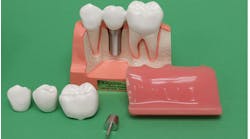It’s discouraging that you need to convince people to pursue dental treatment. Even with technicolor presentations of pictures, x-rays, and models, your patients often say they’ll “think about it.” But before you drop your loupes in disgust, let’s examine how you’ve been discussing treatment and why the traditional methods of treatment presentation don’t align with motivational research. I’ll show you the steps to a conversation with patients where they become involved in convincing themselves to schedule treatment.
First, there are two terms that you need to remove from your vocabulary forever. I don’t want you to approach another patient thinking you must “overcome” their objections. Frankly, this is a brutal term, and it implies that you need to manipulate patients into dropping their fears and questions. Would you want a salesperson to approach you with the goal of “overcoming” your concerns?
I also take issue with the term “treatment presentation” because it implies a one-way lecture from dentist to patient. These terms together lead to a mindset that patients naturally resist—you are the all-powerful dentist telling them what they should do.
Also by Sharyn Weiss:
Why you should ditch your bonus plan
Let’s align ourselves on the philosophy behind what I’m going to teach. We need to agree that the patient and dentist must engage in a diagnosing dialogue. Diagnosing problems is your clinical happy place, but too many dentists become so enamored with this that they deliver mini lectures. If your patient listens to you for more than three minutes without saying a word, you’re lecturing instead of conversing. Patients often emotionally check out when you diagnose problem after problem. They nod but they’re not really present.
A second problem with the way many dentists present treatment is they focus on the consequences of not doing treatment instead of the benefits of treatment. This is a crucial mistake because while some people are motivated by fear, threats of dire consequences motivate people only for a short time, and for some people, scare tactics don’t work at all.
The current proof of this psychological principal is how many people don’t want to wear masks or get the COVID vaccine, despite the possibility of serious illness or death. Think about that for a second. If your patients don’t want to protect themselves against the possibility of serious illness or death, the threat of gum disease, bone loss, or even a root canal is not going to move them. So, you need another motivational tool.
This eight-step model walks you through exactly what you or your hygienist can say when you want to involve the patient. Eight steps may sound scary, but you can contract or expand them in whatever timeframe you have with a patient.
The eight-step model
The first three steps are patient engagement steps that invite the patient into the diagnostic process.
- I’m noticing . . . Use layman’s terms regarding what you see. Unless you have an engineer in the chair, make this segment short.
- What have you observed or felt? This question involves the patient in codiagnosis. If the patient admits they’ve noticed an issue, explore how this has affected their daily life. You want to elevate their consciousness of the problem so they will convince themselves about the need for treatment. If they say they haven’t observed anything, then show x-rays and photos to raise their awareness.
- What do you know about X and its effect on the body? This encourages the patient to reveal their dental IQ and allows you to connect to their level of knowledge.
The next two steps focus on the benefits of treatment. Spend the bulk of your conversation describing how the treatment will help them achieve what they want. Desire is a much more powerful motivator than fear.
- Because I’m seeing X, I recommend . . . Justify your treatment recommendation by linking it to their condition or motivators. This is the equivalent of showing your work on a math test. You’re revealing why the treatment is absolutely the best thing for this patient.
- This solution will help you to . . . This step is the most important. Describe the emotional and physical benefits of the treatment. Explicitly link these benefits to the patient’s motivators. “It’s because you’re concerned about saving money that I’m recommending this.” “This treatment will let you eat what you want again.” “This treatment is going to make such a huge difference in your smile.” A great way to describe benefits is to begin by saying, “Imagine when you can . . .”
Next, anticipate the patient’s concerns like you’re a mind reader. Instead of “overcoming” their objections, demonstrate that you understand their perspective.
- It may be tempting to think you don’t need to do this, but here’s what could happen. Now you can describe the costs and consequences of not doing the treatment. When you identify the objection before the patient does, you allow them to relax.
Next, ask the patient to identify the benefits and results they want and watch them make the case for treatment themselves.
- I see a great benefit in taking care of this now, but how do you feel about this? What do you see as the most important benefit? What would change in your life once you complete this treatment? People do not argue with their own data. You want your patients to be more invested in the outcomes of treatment than you are.
In the last step, ask the patient for feedback about fees and to commit to their next appointment. Although many dentists don’t like to talk about money, concern about fees is patients’ primary reason for not scheduling treatment. Your job isn’t to make a financial arrangement, but to explore any emotional concerns about the fees.
- The fee for this ranges from X to Y. How does this match what you were expecting? Given everything we’ve talked about, what are your thoughts about the next best step? Share information about fees just like you provided information about the treatment plan. If the patient doesn’t express a money objection, then ask the question about commitment. With this, you show the patient that they’re in control of their own treatment and you’re acknowledging their agency to make their own decisions.
Benefits and features of eight-step model
Note that this framework creates a conversation between you and the patient. You present yourself as their advocate, not an adversary who wants to do treatment for your own mysterious clinical desires. You are alternating between giving information (advocacy) and getting information (inquiry).
By focusing on the positive outcomes of the treatment, you offer the patient something to look forward to. You’re not selling a treatment plan; you’re selling a life improvement. People will pay untold amounts of money to get something; but they’ll penny pinch and second guess when they need to spend money to prevent something painful. By creating room for the patient to be an active participant in the conversation, they create their own motivation for moving forward. This framework gets you out of the motivation treadmill and puts the onus on the patient where it belongs.
Editor's note: This article appeared in the February 2022 print edition of Dental Economics.






